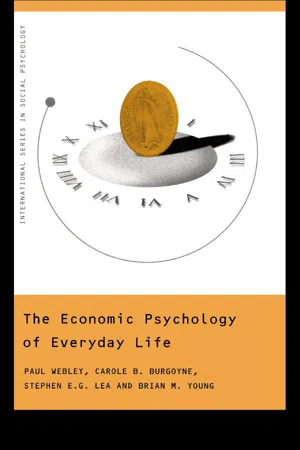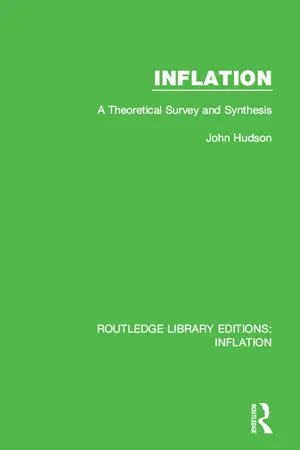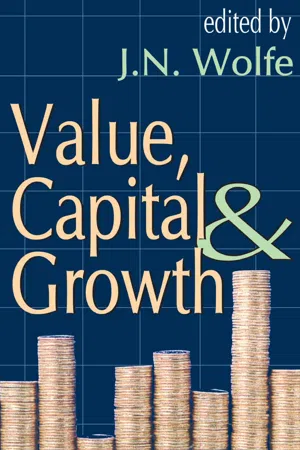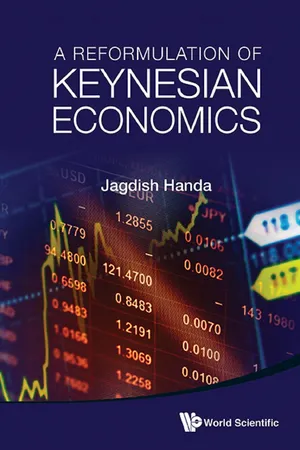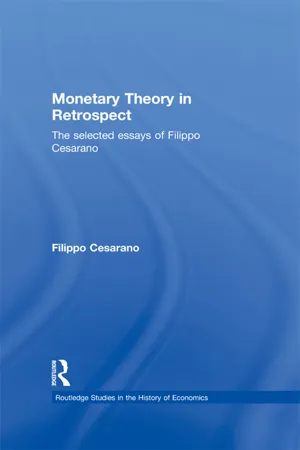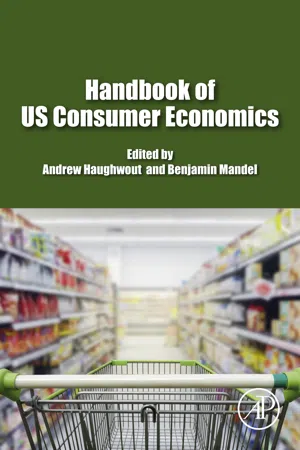Economics
Expectations Theory
The Expectations Theory in economics suggests that the long-term interest rates are determined by the market's expectations of future short-term interest rates. According to this theory, investors are indifferent between short-term and long-term bonds, assuming that they expect the same return from investing in either. This theory plays a significant role in understanding the dynamics of the bond market.
Written by Perlego with AI-assistance
Related key terms
Related key terms
1 of 4
Related key terms
1 of 3
10 Key excerpts on "Expectations Theory"
- eBook - ePub
- Friedrich A. Lutz(Author)
- 2017(Publication Date)
- Routledge(Publisher)
18 with the first variant. This can easily be shown: He, who expects that the long rate will rise, anticipates a loss on capital account; if the yield in the long market is to be the same as in the short, the rate of interest on long-term securities must be high enough to make the interest less the capital loss equal to the interest obtainable in the short-term market. The short rate thus lies below the long rate if the participants in the market expect the long rate to rise. The reverse will be true if they expect the long rate to fall. This conclusion rests on the same type of reasoning as the first variant of the expectation theory – namely, that arbitrage operations will bring it about that all types of investment will over the same time span carry the same yield. If one assumes perfect foresight – so that the expected long rate is nothing other than the average of the successive short rates expected over the time span under consideration – the two approaches will yield the same result. Hence they are indeed consistent.This second variant of the expectation theory does, however, have great advantages. In the first place, it is much more realistic since speculators in long-term bonds are concerned with the prices of these bonds in the relatively near future and not with short rates over a long period ahead. By assuming that a participant in the market has expectations about the price of the long-term bond at the date when the short-term security falls due, we get along with the simple comparison of the current short-term interest with the yield on the longer-term bond (interest plus change in capital value) expected for the same time span. The positive theory in the fifth part of this book will be developed along these lines.4 The more recent representatives of this theory are: J. R. Hicks, Value and Capital (2nd ed., Oxford, 1946), chs. 11-13; F. A. Lutz, ‘The Structure of Interest Rates’, Quarterly Journal of Economics, 55 (1940-1941) 36-63; reprinted in Readings in the Theory of Income Distribution (Philadelphia-Toronto, 1946), pp. 499-529; J. W. Conard, An Introduction to the Theory of Interest (Berkeley and Los Angeles, Calif., 1959), pp. 287-367; D. Meiselman, The Term Structure of Interest Rates (Englewood Cliffs, N.J., 1962); J. B. Michaelsen, ‘The Term Structure of Interest Rates: Comment’, Quarterly Journal of Economics, 77 - eBook - ePub
- Paul Webley, Carole Burgoyne, Stephen Lea, Brian Young(Authors)
- 2002(Publication Date)
- Psychology Press(Publisher)
Economists generally use a different approach to expectations, which, as is to be expected, uses the concept of rationality. This is the rational expectations approach, which has revolutionised macro-economics over the past decades. The idea at the heart of rational Expectations Theory is very simple: it is that people use relevant information to make forecasts of the likely future value of economic variables (such as inflation and unemployment rates) and that, on average, these will be equal to the true values. In other words, people will not make systematic errors in making forecasts, which are the result of current information processed optimally. Muth (1961, p. 376) expressed this idea succinctly—‘expectations, since they are informed predictions of future events are essentially the same as predictions of the relevant economic theory’. This does not mean that people use all possible information nor that all this information is fully processed. But if someone ignores government or Central Bank announcements in forming an expectation of the rate of interest, that person will learn that this is misguided and pay attention to these announcements in the future.To psychologists this may sound implausible and it may also not be clear why this is important. What it implies is that people will learn to anticipate economic policy changes and change their behaviour as a result. So whilst the traditional macro-economic approach treated the economic policymaker as an engineer (someone playing a game against nature), the rational expectations approach sees the policymaker as being engaged in a game against other players—the participants in the economy. This does not imply that people have a good understanding of economics and know what the consequences of government announcements are. Most people will rely on the media or experts. What it does imply is that on aggregate people will be acting as rational Expectations Theory predicts.Rational Expectations Theory is very important in current macro-economics (for good accounts see Miller, 1994, or Sheffrin, 1996). Our interest, however, is more psychological: how do people solve the problem of forming good expectations so that they make appropriate medium- and long-term decisions? In addition to the rational expectations model, economists have proposed an adaptive expectations model. This assumes that people will use their past forecasting errors to change their current expectations. So in the case of exchange rate expectations (which would be involved in a decision to buy foreign currency for a holiday now or later) this would be expressed as: - eBook - ePub
Inflation
A Theoretical Survey and Synthesis
- John Hudson(Author)
- 2016(Publication Date)
- Routledge(Publisher)
Chapter 3 Expectations of InflationExpectations as a concept seem to be growing increasingly important, and much of economic theory is now being rewritten to take explicit account of them. Indeed in future years when economists look back at this era, it may well prove to be that this is seen as the thread that links together much of the work being done, as in a similar manner the rejection of the assumption of perfect knowledge characterises much of the work done in the interwar period. However, this awareness of the importance of expectations is not a new phenomenon. Marshall (1920), for example, was aware of the importance of the concept, although as Shackle (1967) comments, this was not a trumpet he chose to blow too hard. But it was really in Sweden that the importance of expectations in economic theory was first fully appreciated, with the work of Myrdal (1939), amongst others, while in England at about this time Keynes’ General Theory had just appeared, in which expectations are of prime importance.Most of this early work was connected with the effects of expectations, rather than with how they were formed. Keynes, at least, thought that some expectations were closely akin to a random variable, and hence unexplainable, that is, unless a theory of animal spirits can be provided. Since then, and particularly since 1960, a substantial volume of literature has appeared concerned with how expectations are formed. This can be divided into two fairly distinct parts, that dealing with theoretical considerations, and that which is mainly empirical in nature. There has, of course, been some interchange between these two avenues of research, but unfortunately this has not been common, and they have by and large remained separate areas. It is hoped in this survey not only to summarise these two approaches, but to forge closer links between them. - eBook - ePub
- Maria Brouwer(Author)
- 2012(Publication Date)
- Routledge(Publisher)
Profits and losses appear sequentially in markets that are driven by collective opinion. Markets that are steered by individual judgments, however, will show profits and losses simultaneously. Profits outweigh losses in dynamic economies featuring productivity growth. Net investment is sustained as long as average profits match investor expectations. Capital and labor shares can remain constant, if a constant fraction of national income is invested and expected returns on investment are realized on average. Rates of return will, however, either exceed or fall short of expectations in individual cases. Markets with a sufficient number of uncorrelated investment decisions will be more stable than an economy that is driven by collective opinion. The economy is no longer steered by a force heading in one direction, but stays on course by a multitude of forces going in different directions. Stock and real estate booms would be absent, whereas stock and real estate prices show a wave like pattern, if they are driven by collective opinion, erring both on the up and the downside.Expectations in economic theoryBefore KeynesIt was mentioned above that expectations are central to investment decisions. However, economics has only a short history modeling expectations. Expectations entered economic theory with the publication of Keynes’ General Theory in 1936. English classical theory assumed that investment opportunities were equally obvious to all. Investors were looking forward, but expectations were always realized; the future being related to the present in unmistakable ways. The only brake on investment was a lack of savings.Neoclassical theory that was developed in the late nineteenth century differed from classical economic theory. Neoclassical theory introduced the concepts of marginal costs and benefits. Neoclassical economists argued that producers and consumers decided by weighing marginal costs and benefits. Producers would expand output until a point was reached where the last unit produced did not contribute to producer surplus. Consumers weighed the utility they derived from consuming an extra hotdog while standing at the stand against its costs. Marginal analysis is located in present time. Capital would flow into and out of an industry in response to exogenous demand and supply shocks until profits were restored to ‘normal’ levels. Neoclassical theory depicts investors as myopic. This differed from classical economics, where investors appraised investment projects based on long term effects. But investors did not need to individually appraise investment projects in classical theory, since good projects were known to all. Scarcity of savings allowed firms to reap profits. Both theories, therefore, assumed that scarcity rents were the source of profits. Some production factors were more scarce than others; capital and land being the pivotal examples. Both theories also did not distinguish between plan and realization. Classical economists assumed that the quality of investment plans was known beforehand, while plans did not figure at all in neoclassical theory. - eBook - ePub
- J. N. Wolfe, Gabriel R. Ricci(Authors)
- 2017(Publication Date)
- Routledge(Publisher)
1Let us continue the fiction that the only forms of wealth are paper assets and money. Paper assets can be of two kinds, however, the short and the long term. Corresponding we have a short and a long interest rate. It is clear that the rates and the expected rates that enter into the asset demand for money are for long term securities.Obviously there is no direct measure of the long term rate expected in future periods. But in Value and Capital , Hicks set out a theory which related expected short rates to existing long and short rates. If we make three important assumptions (a) that persons hold securities to maturity and (b) that there are single valued expectations and (c) there are no transactions costs, the rates of interest must satisfy the equation2( 1 + R) n= ( 1 +r 1) ( 1 +r 2 e) ( 1 +r 3 e) ... ( 1 +r n e) ,where R is the ‘long’ term rate of interest, that is, the rate on a security which matures in n periods;rxis the rate on one period loans in the first period;rf is the expected short run rate in the zth period.Given the long rate R and the short rate r, one can calculate the geometric average of future expected discount factors (l+re). A sort of average of expected short rates is implied by the existing long rate and short rates. But individual expected short rates (even granted we restrict the rates to strictly positive values) may assume any values.This theory derives expected short rates from short and long rates. In the demand for money, however, as distinct from investigations of the term structure of interest rates, we are primarily concerned with getting measures of the expected long rate from evidence of the short and long rate. Since the essence of the asset demand for money is the shift between money and long term paper because of the chance of capital loss and gain, it is clearly not possible to employ this theory which assumes that the investor holds long term paper assets until they mature. Let us examine now a transactor who considers transfers between - eBook - ePub
- Jagdish Handa(Author)
- 2015(Publication Date)
- WSPC(Publisher)
It argues that, by the nature of how human beings think, economic agents always hold a “view” or “views” (whether vague or precise) on how the future values of the variable in question will evolve. Economists believe that the expected values should be based on a theory of the structure of the market in question or the economy. Since different theories are likely to yield different expected future values of the variable in question, these expected values may be designated as “theory-specific” or “model-specific.” Section 7.3 considers the variety of model-specific EH in macroeconomics. Section 7.4 discusses the time dimension relevant to the formation of expectations. Sections 7.5 and 7.6 consider the imperfection of knowledge and its implications for EH. Section 7.7 focuses on the classical (strong) REH, with Sec. 7.8 illustrating the use of this hypothesis in the context of a compact classical macroeconomic model based on Lucas (1972, 1973). Section 7.9 lays out what we consider to be the essential aspects of the Keynesian EH and our proposal for an EH. It argues that such hypotheses need to include an autonomous component and an endogenous one. 7.1 The Stylized Facts on Expectations in Economics Economic agents form expectations on the future values of many variables. It would be useful to start by listing a set of stylized facts about these expectations. On these, we offer the following list, though, obviously, without expecting a consensus on some of the following items. i. Expectations of the future values play a very significant role in the determination — in addition to their other determinants such as technology and preferences, etc. — of the current and future values of several macroeconomic variables. ii. The impact of expectations over short periods ahead is well established. This impact is especially evident in the prices of some types of assets. iii - eBook - ePub
- Jagdish Handa(Author)
- 2002(Publication Date)
- Routledge(Publisher)
21.6 .21.3 FINANCIAL ASSET PRICES
Financial assets are not generally held for their direct contribution to the individual’s consumption. They are held for their yield, which is often uncertain, and the individual balances the expected yield against the risks involved. This is the basic approach of the theories of portfolio selection. These theories focus on the yields on assets rather than on the prices of assets, while the theory of the demand for consumer goods focuses on the prices of commodities.The price of any asset is uniquely related to its yield and can be calculated from the following relationship. In any period t , for an asset j ,where:rjtyield on the j th asset during period tpjt jth asset’s price in period tj th asset’s (expected) price in period t + 1That is,xjt jth asset’s coupon rate in period tHence, a theory of the rate of interest is also a theory of the prices of financial assets. Alternatively, the yields on assets may be explained by a theory of asset prices. Such a theory at a microeconomic level would consider the market for each asset, and use the demand and supply functions for each asset to find the equilibrium price of the asset. At the macroeconomic level, the theory could focus on the average price of financial assets, with macroeconomic demand and supply functions. These demand and supply functions would have the prices of the assets as the relevant variables. The loanable funds theory as stated in the preceding chapter could then be reformulated to replace the demand and supply of funds (or securities) in terms of the rate of interest by the demand and supply of securities in terms of their prices, so that it would become a theory of asset prices. - eBook - ePub
- Filippo Cesarano(Author)
- 2012(Publication Date)
- Routledge(Publisher)
Part 2 Expectations and Monetary PolicyPassage contains an image [7]
The Rational Expectations Hypothesis in Retrospect
By FILIPPO CESARANO *
The rational expectations hypothesis is at the center of current debates in economic theory. The importance of this theoretical innovation has stimulated a number of studies, including analyses in the unfashionable field of the history of thought, the 1979 article by Brian Kantor being a first example. Historical investigations on the subject of rational expectations are of interest since it is held that this theory has revived the teachings of the classics, inasmuch as it provides the cornerstone of the recently developed approach known as “new classical macroeconomics.” The present note examines some specific aspects, as yet rot emphasized in the literature, concerning the relationship between rational expectations and classical monetary theory. In particular, the following results will be shown: the fundamental implication of the rational expectations hypothesis, that is, that only unexpected changes in the money stock influence the real sector of the economy, is a basic tenet of classical monetary theory as well and is founded upon the very argument according to which agents efficiently use the available information in order to take account of the consequences of policy measures (Section I). This common analytical framework notwithstanding, classical analysis of the role to be assigned to the monetary authority reflects a different appraisal of the dimension of the information set (Section II).IClassical economists have discussed at length the effects of both unexpected and expected changes in the money stock, but have paid far greater attention to the former. In the monetary system of the time, that is, a metallic standard, variations in money supply essentially originated from the balance of trade and from the discovery of new mines. Thus, given the lack of regularly collected statistics, the classics normally assumed such variations to be unexpected.1 - eBook - ePub
An Introduction to Economic Dynamics
Modelling, Analysis and Simulation
- Srinivas Raghavendra, Petri T. Piiroinen(Authors)
- 2023(Publication Date)
- Routledge(Publisher)
The law of iterated expectation implies that an agent’s expectation today about tomorrow’s expectation of the day after tomorrow’s price is equal to today’s expectation of the day after tomorrow’s price. A simpler way to understand the intuition behind the law is to imagine a forward contract that a supplier places for supplying an agreed quantity of an agricultural commodity, say wheat, at an agreed price in a month from now. Then the law of iterated expectation implies that the future price that is set today is an average of expectation made today about tomorrow’s expectation of the day after tomorrow’s expectation and so on, of the end of the period price.If we continue the iteration process for pt+2 , pt+3 , … and substitute for Et [pt+2 ], Et [pt+3 ], … in the price equation (7.20) we getor(7.25)p t=11 + αm t+11 + αα1 + αE t+mt + 111 + α2α1 + αE t+ …mt + 2(7.26)p t=11 + α∑k = 0∞kα1 + αE t,mt + kwith Et [mt ] = mt . The expression (7.26) simply shows that today’s price level pt is a weighted sum of today’s and the expected future nominal money supply, where the weights get smaller the further in the future we look. Thus, in the scenario where the money supply growth is a variable, the rational expectation calculation about the future price level converges to agents’ expectation about the future money supply, and therefore the equilibrium price is determined by the money supply.The rational expectation hypothesisThe reader might wonder about the wisdom of the rational agent to know the underlying model of the economy, i.e. the quantity theory of money, and look at the money supply process for estimating expected inflation. This is one of the fundamental assumptions of the rational expectations hypothesis. It assumes that the rational agent knows the ‘correct model’ of the economy. Even if the agent makes some error in their expectation calculation, the rational expectations hypothesis assumes that the errors are uncorrelated over time and tends to zero on average. Furthermore, the hypothesis also assumes that the errors are uncorrelated across the variables in the model. Readers might wonder, given the power of rationality that agents seem to posses, how errors appear in the first place. We will discuss this point below. - eBook - ePub
- Andrew Haughwout, Benjamin Mandel(Authors)
- 2019(Publication Date)
- Academic Press(Publisher)
Chapter 10Consumer expectations and the macroeconomy
Giorgio Topa Research and Statistics, Federal Reserve Bank of New York, New York, NY, United StatesAbstract
This Chapter provides an overview of the growing literature on eliciting and using subjective expectations data in economics. Expectations are a key component of any model of decision-making under uncertainty, and drive economic choices by agents in a broad variety of realms. They are also carefully monitored by practitioners, financial market participants, and policy-makers—for instance in the conduct of monetary policy. Economists have traditionally been reluctant to collect and use direct data on expectations. This has changed over the last three decades, with researchers increasingly collecting quantitative measures of subjective expectations and eliciting the entire subjective probability distribution over future outcomes for a variable of interest. Expectations data are consistent with basic rules of probability, are predictive of realized outcomes, and are informative in the sense of exhibiting patterns that are consistent with theory. Subjective expectations data can be integrated in the analysis of structural models of behavior, reducing model misspecification and allowing researchers to better construct counterfactual experiments.Keywords
Consumer expectations; Subjective expectations; Density forecasts; Uncertainty; Survey of consumer expectations1. Disentangling preferences and expectations
Household expectations have long been a fundamental ingredient in any model of the macroeconomy. In the most basic dynamic macromodels, the intertemporal decision on how much to consume today versus save for tomorrow hinges on expectations about future returns and determines equilibrium aggregate consumption, saving, and ultimately the overall level of economic activity. More broadly, household decisions regarding housing, job search, investments in education, credit applications, household formation, fertility, residential mobility, retirement, and more all depend on agents' expectations about various aspects of the housing, labor, and credit markets, returns to education, social security, mortality, etc.
Index pages curate the most relevant extracts from our library of academic textbooks. They’ve been created using an in-house natural language model (NLM), each adding context and meaning to key research topics.
Explore more topic indexes
Explore more topic indexes
1 of 6
Explore more topic indexes
1 of 4

